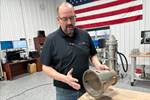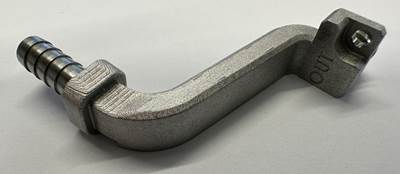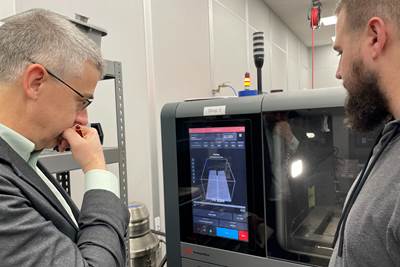3 Attributes of the “Second Wave” of AM Part Producers
Successful contact manufacturers in additive look more and more like successful contract manufacturers in general.
The second wave of contract part producers using additive manufacturing has arrived. The first wave of AM contract shops included companies demonstrating that AM can be used for production — that it can be systemized, can deliver repeatability. Companies from this first wave are still thriving. But more recently, a second wave has come into view: These are the AM part providers that, knowingly or not, benefit from earlier successes. They accept it as given that AM is a production process, and they serve a now-broader array of customers that see 3D printing as an option for their production needs.

My conversation with Freeform technology co-founders Chris Aiello (middle) and Nate Higgins (right). In addition to the report about Freeform linked within this article, we also produced a video illustrating the binder jetting production workflow through Freeform’s shop.
Examples of second-wave AM providers appear in various articles we have posted recently. Innovative 3D Manufacturing is an Indiana contract manufacturer using laser powder bed fusion, and Freeform Technologies is a Pennsylvania contract manufacturer using sinter-based processes including binder jetting. And I include in this list 3DEO, even though this company dates back as far as first-wave producers. As our article about this company describes, this business has clarified its services and its role with customers in a way that matches the operation and disposition of second-wave AM companies.
What are the distinctions? The articles convey three different stories, but the similarities are plain. AM production providers that have found their footing more recently seem to have several characteristics in common. They include:
1. Humility. This is the most subjective and shaded of the characteristics I’ll cite, because practically all manufacturers are humble. Making parts to match prints is an avocation that requires it. Yet I see a shift in the latest AM part producers: There is now little advocacy of AM, including less in the way of presenting provocative trophy geometries made additively. The attitude instead is more one of readiness to see 3D printing considered and allowed to compete for parts the customer cares about. In Innovative 3D’s case (the article gets into this), those parts are often straightforward hardware pieces that would have been cast, except for additive’s significant leadtime advantage.
2. Embrace of established processes. Innovative turns away most potential jobs, because the company leader prefers to advise which alternative process (sheet metal work, casting, machining or whatever it might be) can make the part more effectively than 3D printing, if this is the case. 3DEO has machining built in as part of its AM process. And Freeform considers it foolish that an AM part producer would run without the methodologies (5S, Kaizen, Lean) that have proven their worth in manufacturing broadly. The increasing embrace of established manufacturing processes and practices is a natural outflow of AM itself becoming more established.
3. Conversations with customers. This is the one that leaps out — it is prominent in each of the articles I’ve cited. As a digital manufacturing process, AM allows the part file to be submitted to a part producer that then acts as a black box to make the part. But in practice, all manufacturing, additive or otherwise, is more nuanced than this. Effective production of a part that delivers the customer’s aims arises from a shared understanding of expectations and priorities beyond what is expressed in the digital file. In fact, even a company that is known for its ability to manufacture from uploaded files, Protolabs, relies on conversation to realize the customer’s vision. The customer/manufacturer interaction is a basic element of production that has naturally become basic to additive production as well.
What all these characteristics have in common is a single concern: cost. The humility is an acceptance that economics will and should determine the process chosen. Process methodology is cost-driven. And the client conversation focuses on finding the opportunities within the part’s allowables to bring the cost down. All these characteristics could then be seen as expressions of just one big characteristic: an increased focus on cost in AM production.
And manufacturers have always had this focus, of course, including the first-wave additive producers. But there were some greater freedoms in the beginning. They came from the arrival of the first high-end parts that could only be made additively, the new opportunities for which no other process offered a realistic alternative. Those wins have been won. To be sure, plenty of other parts, both now and to come, offer similar unrivaled opportunities. But AM’s expansion today comes largely from work for which AM is not the sole choice, just the economical one. As AM increasingly competes in spaces served by established manufacturers, its providers will more and more come to resemble those established manufacturing businesses.
Related Content
Large-Format “Cold” 3D Printing With Polypropylene and Polyethylene
Israeli startup Largix has developed a production solution that can 3D print PP and PE without melting them. Its first test? Custom tanks for chemical storage.
Read MoreMultimaterial 3D Printing Enables Solid State Batteries
By combining different 3D printing processes and materials in a single layer, Sakuu’s Kavian platform can produce batteries for electric vehicles and other applications with twice the energy density and greater safety than traditional lithium-ion solutions.
Read MoreUnderstanding HP's Metal Jet: Beyond Part Geometry, Now It's About Modularity, Automation and Scale
Since introducing its metal binder jetting platform at IMTS in 2018, HP has made significant strides to commercialize the technology as a serial production solution. We got an early preview of the just-announced Metal Jet S100.
Read MoreHow to Build 10,000+ Shot Molds in Hours
Rapid tooling isn’t so rapid when it takes days to 3D print a metal mold, and then you still must machine it to reach the necessary tolerances. With Nexa3D’s polymer process you can print a mold in hours that is prototype or production ready and can last for more than 10,000 shots.
Read MoreRead Next
How Machining Makes AM Successful for Innovative 3D Manufacturing
Connections between metal 3D printing and CNC machining serve the Indiana manufacturer in many ways. One connection is customer conversations that resemble a machining job shop. Here is a look at a small company that has advanced quickly to become a thriving additive manufacturing part producer.
Read MoreFrom Parts to Problem-Solving: 3DEO's Evolution with Intelligent Layering Metal 3D Printing
The technology developer and parts provider is moving beyond transactional 3D printing, in favor of holistic solutions where its AM process can have the greatest impact.
Read MoreFreeform: Binder Jetting Does Not Change the Basics of Manufacturing
Rather than adapting production methodologies to additive manufacturing, this Pennsylvania contract manufacturer adapts AM to production methodologies. In general, this starts with conversation.
Read More








.png;maxWidth=300;quality=90)














